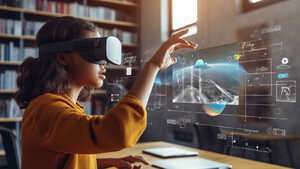Thought leadership
What is the Future of Virtual Reality in Education?
While virtual reality might seem very much like a 21st-century invention, its introduction into popular culture – at least as a concept – can be traced all the way back to the 1930s.
The plot of the short story Pygmalion’s Spectacles, first published in 1935 by science fiction writer Stanley G. Weinbaum, describes the use of a pair of goggles which allowed the user to experience a holographic, fully-generated universe, with access to the full gamut of sensory touchpoints. Wearers of the goggles were able to see, smell, taste, and touch the artificial world around them.
Fast forward nearly a century, and the idea of virtual reality is no longer confined to the pages of science fiction or the brainchild of visionary creators. It’s fast becoming a technology tool that’s impacting all facets of modern society – including education.
But what are the benefits of adopting virtual reality in the classroom, and what might we expect from the future of this cutting-edge technology?

What are the origins of virtual
reality in education?
We can likely pinpoint the acceleration of virtual reality as a viable education tool with the release of the Oculus Rift in 2012. The VR headset, primarily aimed for use in video games, had the ability to immerse the user in a computer-generated 3D world. Since the release of the Oculus Rift over a decade ago, VR has undergone a seismic technological revolution; a transformation not just limited to the video game world but for the entire digital landscape and all its many applications.
As headsets have become more refined and the technology used to run them more powerful, VR has outstripped its initial gaming-centric purpose and found utility in a variety of specialist fields, from medicine and architecture to work training and education.
With less prohibitive costs, coupled with rapid technological advancement, VR is now a realistic option for schools, with pioneering applications such as Google Expeditions creating a new wave of learning possibilities. Using 360-degree cameras to create the virtual environment of your choice, students are able to visit museums, explore ancient monuments, swim with sharks, even step into outer space – all without leaving the classroom.
A modern approach to
traditional learning models
Despite the advancement in technology in the last two decades, the core building blocks of student learning have remained largely the same throughout the course of history. Leaning models based on fact retention, studying for exams, and absorbing information through textbooks still typify a traditional classroom experience.
With virtual reality, however, students can now engage with conventional educational practices in new and more immersive ways. A VR headset can whisk students away from their desks to the foothills of Mount Fuji or the centre of a Roman Colosseum, or allow them to conduct experiments with reactive chemicals without the risks of physical harm. Students not only see these virtual environments but interact with them – creating a dynamic, responsive learning experience.

How can virtual reality
benefit the classroom?
Learning through experience
Virtual reality is able to bridge the gap for those students who might otherwise struggle to absorb or visualise information by presenting engaging, real-world scenarios. Simulated environments can immerse students within a subject, making them feel connected with the topic they are exploring.
Meanwhile, educational experiences can be further enhanced by the use of integrated sensors within VR devices. As users’ actions and movements are tracked, VR displays are able to adapt accordingly to create a fully interactive sensory environment. Students who learn more effectively through experience are better able to retain knowledge and apply learned concepts in practical situations.
Virtual reality for STEM-related careers
For students in higher education, virtual reality is a valuable tool for helping develop the core skills associated with their chosen post-graduate fields. While STEM industries adapt to the ever-changing technological landscape, educators are able to prepare future workforces through VR-based learning.
With VR headsets, students can learn about the structural properties of bridge building, explore the inner workings of the human heart, study the growth habits of giant redwoods – all from the comfort of the classroom. By giving students the opportunity to comprehensively engage with STEM industries and the practical skill sets needed to succeed, teachers can provide a clearer idea of what to expect from their chosen career path.
Distance learning
With a robust internet infrastructure and the right software and devices, most virtual reality applications can be easily accessed from anywhere and at any time. Through universal accessibility, schools and trusts can create virtual learning portals, removing both time and location barriers, as students no longer have to commute to a physical institution – saving both time and resources. Students can attend classes, field trips, seminars, or workshops through virtual platforms, creating an inclusive learning environment that accommodates a wide variety of schedules and geographical considerations.
Pre-recorded virtual lessons can be revisited multiple times, allowing students to untangle complex ideas at their own pace; a flexible, individual learning experience that can only help to benefit students and their educational growth.
Virtual field trips
Academic studies have long since championed the benefits of using immersive technology to enhance the learning experience, and virtual field trips represent a cost-effective way for students to visit real-life locations across the world. Instead of reading about Ancient Greece from a textbook, users are able to visit the Acropolis of Athens and the Parthenon in virtual reality.
Not only can virtual field trips provide an enjoyable experience away from the classroom; research has shown it has the ability to improve students’ intrinsic motivation to learn. Replace lectures and non-interactive tools with virtual engagement and participation, and students find new ways of connecting with the material.
Virtual field trips also provide the added advantage of increased accessibility; a much cheaper alternative than visiting far-off destinations that might otherwise test a school’s budget.

How can VR help students with
learning difficulties?
The immersive classroom model has been shown to be particularly beneficial for those students with learning difficulties. For children who face challenges in traditional classroom environments, educators can create safe and controlled surroundings using virtual reality technology.
While some students may struggle using VR headsets, the immersive classroom approach enables teachers to deliver lessons that closely resemble conventional learning spaces. This level of familiarity encourages students to explore virtual environments without feeling confined.
As noted in a study by Dorothy C. Strickland, virtual reality has long demonstrated a particular efficacy in assisting students with autism. Notably, students have exhibited an ability to transfer skills acquired within the virtual realm to real-world scenarios, including street navigating and fire safety.
How can Computeam help?
The continuous advancement of technology holds great promise for the role of virtual reality in education over the next decade. Despite its potential, however, with constrained budgets and schools’ inability to provide the necessary technology training to help teachers embrace this emerging technology, the integration of VR into traditional classroom settings remains a challenge.
But, as education practices move further on to online platforms, virtual reality has the ability to provide a hugely beneficial addition to the traditional lesson plan, making learning accessible, safe, engaging, and fun. If you’d like to find out more about how VR technology could benefit your school, please do get in touch.
How The Cloud Improves Educational Outcomes
With the right technology and robust internet infrastructure, the scope for educational growth is seemingly limitless.
Posted on September 9th 2025




 Learning Locker
Learning Locker Climate project
Climate project